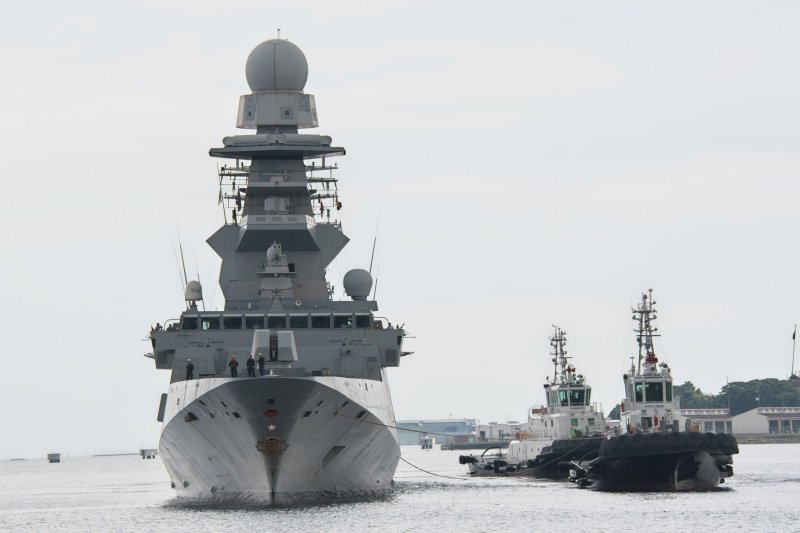The Italian Navy, Italian-French European multi-mission frigate Alpino arrives at Japan Maritime Self-Defense Force Yokosuka Naval Base in Yokosuka, Kanagawa-Prefecture, Japan, on August 22. File Photo by Keizo Mori/UPI |
License PhotoOct. 25 (UPI) — In the lead-up to his election, Japanese Prime Minister Shigeru Ishiba floated the idea of an “Asian NATO” to deter the increasing aggressiveness of China in the Asia-Pacific region.
The prospect of setting up an alliance in the Asia-Pacific region resembling the collective defense promised by Article 5 of the North Atlantic Treaty is hindered by the reality that few, if any, countries are willing to commit to the collective defense of an area in which a nuclear nation is actively testing the limits of its power.
The proposal faced skepticism from regional players, particularly ASEAN countries, which fear that such an alliance could increase economic tensions with China and disrupt their stance of non-alignment.
Ishiba has since backed away from this proposal and did not mention it during his first overseas visit with ASEAN leaders earlier this month.
“There are two ways to read it,” Robert Ward, Japan chair and director of Geo-economics and Strategy at the International Institute for Strategic Studies said in an interview with UPI.
“One is to take it literally. It is a complicated thing to bring about, not least of which because you would need constitutional change [in Japan] ….The other thing is to look at it as Ishiba floating ideas … this idea not in itself, but what he’s trying to convey with this in terms of where Japan’s future security debate should go.
“What he’s really saying is that ‘the threat from China is so significant that we really need to link up with like-minded countries.'”
Chinese Defense Ministry spokesman Wu Qian said in a statement earlier this month in response to Ishiba’s proposal that Japan “often hypes up the non-existent ‘China threat’ to divert the international community’s attention from its own military expansion.”
China’s military exercises earlier this month encircled Taiwan, setting a record with the highest number of Chinese military aircraft crossing the sensitive median line of the Taiwan Strait, while Chinese coast guard vessels intentionally collided with Philippine ships during maritime standoffs earlier this year.
Japan and its regional allies are concerned that China’s threats to the region are far from “hyped-up” and are part of a greater normalization of incremental encroachments in the region.
“We are facing a post-peak globalization planet that now is operating essentially under new rules of the game,” Mike Studeman, national security fellow at MITRE and former rear admiral and commander of the U.S. Office of Naval Intelligence, said at a Foreign Correspondents’ Club of Japan press conference on Friday.
“When one country that size becomes very zero-sum and mercantilist, then it has very strong repercussions for many other countries that are interdependent,” Studeman said.
One effect of this, however, has been the recent doubling down on Japanese defense spending proposals that would have, in the recent past, seemed unthinkable.
Although skepticism exists about the proposed timeline, Japan’s latest National Security Strategy, published in 2022, announced an increase in military spending to 2% of its GDP. While on par with the proposed military spending for NATO members, this potentially puts Japan on track to become the third-largest military in the world.
However, constitutional limitations prevent this from being called a “military” and would still restrict its offensive capabilities. The weakening of the yen is another obstacle that could prevent many of Japan’s defense ambitions from coming to fruition.
While an “Asian NATO” might be a bridge too far, a plethora of smaller formal and informal defense alliances already exist in Asia and are expanding, in addition to the many cooperative trade agreements in the region set up with half an eye on balancing China’s influence.
The Japan-Philippines Reciprocal Access Agreement created in July is an example, which allows Japanese forces to deploy in the Philippines for joint military exercises. Japan has also signed RAA agreements with Australia and the United Kingdom.
The Quad — an informal alliance between the U.S., Japan, Australia, and India — meets frequently to discuss defense and security in the Asia-Pacific region.
There has been support for the idea that this alliance should be expanded into a “Quint” or a “Quad Plus” to include South Korea. South Korean President Yoon has signaled in the past that South Korea would accept an invitation if one were made.
“What you’ve got now is these groupings, many laterals, some of them more formal than others,” Ward said.
“The beauty of these is that you can link like-minded countries together on specific issues and deal with specific strategic issues in a kind of spot way, whereas if you try to link everybody up, you’d never get agreement.”
An “Asian NATO” may not be possible to create given the geopolitical diversity of the Asia-Pacific. However, the diversity of ideas within Asia on how to manage Chinese aggression have in effect acted as a multiplier, creating a broad spectrum of alliances and approaches that make managing the balancing forces that China is up against much more complex.
“China would love to be able to only deal with these things bilaterally where they maintain all of the advantages,” Studeman said. “This is a time when many states need to work together as a coalition.”

